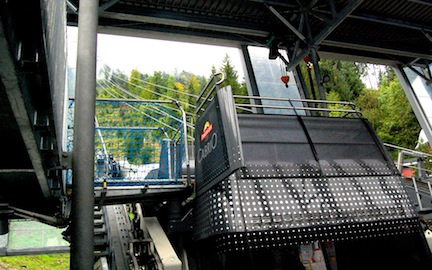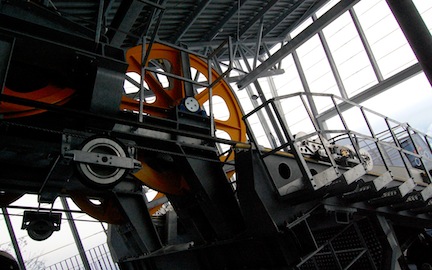While we tend to focus on urban-oriented cable systems on this site, we allow ourselves the room to explore those non-urban systems that are revolutionary, unique or possess certain attributes relatable to the the urban environment.
The Stanserhorn Cabrio meets all three of those qualities. It is, without question, an entirely unique cable transit experience; it’s side-mounted Funifor configuration is revolutionary for Aerial Tram technology and; it’s double-decker, open-top design has the potential to transform how Aerial Trams are integrated into the urban fabric.
One’s first encounter with the Cabrio is an ironic one. To access the base station of the world’s most advanced shuttle-based cable transit system, one must first ride one of the world’s oldest functioning funiculars. Dating from 1891, the wood and wrought-iron funicular that brings one from the village of Stans to the Cabrio base station is charmingly old-school, its vehicles adorned with frosted glass and curtains.
Even the extraneous “drivers” evoke an old-world charm. Combined with the system itself, this creates a wonderful old-world, new-world tension between the two systems that’s resolved by the sole commonality between the two – both are open to the outside air.

Two funiculars shuttle back-and-forth between the village of Stans, Switzerland and the Cabrio base station.
Upon arriving at the Cabrio station, one can’t help but be struck by the scale of the machine in front of them. I once had an operations manager of a system in North America describe his job as being not about maintaining a fleet of vehicles, but instead about managing one giant machine. At no time has this point been driven home to me more than here.
The equipment room and drive machinery is utterly baffling and complex. Even the operations manager admitted he’d have to draw a diagram in order to explain how the entire thing worked. That’s due mostly to the Funifor configuration employed here.
At its most basic, a Funifor combines the double-loop monocable mechanism of the Funitel with the track-rope and fixed grip configuration of an Aerial Tram. This does away with the large arm connecting the grip to the vehicle, thereby allowing for shorter stations and towers – thereby reducing costs. It also reduces sway and wiggle, resulting in higher wind stability than standard Aerial Tram technology. In the case of the Cabrio, by side-mounting the grips and sheaves, this also allows for the stunning open-air upper deck.

Funifor technology allows for severely reduced tower height and carriage arms, thereby eliminating costs.
Despite the cloudy and rainy weather during our tour, the upper deck is where it’s at. There is simply no feeling or experience like it. When inside any aerial cable transit system, there is always a sense of remove. You’ve got this thick piece of glass or plastic between you and the outside world. On the Cabrio’s upper deck, that is entirely stripped away.
Thankfully, the upper deck is solely optional. If you’re afraid of heights, you’re probably going to be more content inside than out. Furthermore, if the weather gets very inclement, opting for the downstairs option is the the better choice. This last point does, however, raise an important question about capacity:

Access to the upper deck of the Cabrio is via an internal spiral stairwell or the gangway in the station (seen above).
Unlike detachable systems, Funifors and Aerial Trams have a capacity limitation that is directly related to system length, vehicle capacity and speed. At 2.32 km long; with a top speed of 8 m/s and; with a vehicle capacity of only 60, the Cabrio can only offer a capacity of 465 pphpd.
But that number is based upon full usage of both the upper and lower decks (each can handle 30 people). In other words, in poor weather the system’s already limited capacity would essentially be halved.
That’s probably not so much of a problem as the Stanserhorn is more of an attraction in summer than winter (as there is no skiing), but it nevertheless raises some concerns.
Despite those concerns, the Cabrio offers significant worth to the urban environment.
In addition to its reduced capital costs (compared with traditional Aerial Trams), it also offers novelty.
You can be certain that cities with highly specialized point-to-point transportation challenges will see the Cabrio as a means to not only solve said challenges, but to also install a system that would be attractive to tourists (and thereby subsidizing local commuters).
It’s unlikely that we’ll see Cabrio’s popping up in cities across the world, but you can be certain we’ll see a few in the years ahead.






6 Comments
So are there only 2 cabins like an aerial tram and that is why the capacity is so reduced? Because if they are with fixed-grips then the cabins can not move through the end stations but go just back and forth
Exactly. They’re fixed and shuttle back-and-forth.
The capacity need to match the capacity of the old funicular. Section one is the funicular, section two is the cabrio. A higher capacity of the cabrio would be useless as thefunicular cannot feed that many passengers. To provide the best service teh vehicle size and the headway of teh vehicle need to ne teh same. Originally the system was built with two section of funiculars. At the time funiculars where limited in length due to the matrials available at the time. Later the upper section was converted to an Aerial tramway. So you see the design of late 1800 still dictates the mode of operation today.
Besides that the Cabrio is an attraction by itself. Increasing the speed and therefore the capacity would decrease the time people can enjoy the ride.
Agreed, Matt. But it is important to remember that even if the Cabrio matches the capacity of the old funicular, the old funicular doesn’t experience a 50% cut in capacity due to rain.
I think you mean 1891 for the funicular…curtains and frosted glass are sooo00 1890’s 🙂
Fair enough. I love crowd-sourced edits. Change made.